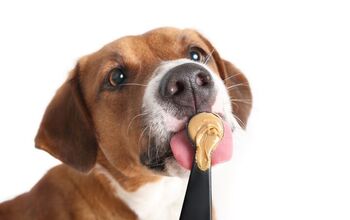8 Tips for Welcoming an Abused Dog Into Your Family

If you’re like me, the thought of buying a puppy from a breeder just isn’t in the cards. I’ve always opted to adopt a rescue – either privately, through a humane society or, in the case of my last four cats, strays that stroll up and settle in.
But while you may think that food, shelter and lots of love are enough to turn a troubled animal around, think again. Many have been through traumatic experiences that compromise their ability to fully enjoy their new homes and they’re going to need a little extra help when it comes to trust. From physical assault to general neglect, long-term confinement or even being removed/isolated from their mothers prior to socialization, abuse can take many forms.
For my two dogs, they were raised in a hoarding/puppy mill situation. As a result, they absolutely love interacting with other dogs however they’re super cautious around strangers (particularly men). And in spite of lots of love and reassurance, they also tend to freeze up if they suddenly notice that I happen to be standing over them. After almost three years in my home, there are still the shadows of a past life and personality issues that I have simply accepted as “who they are” because these will never change. However, there were other traits such as trying to break out of their collar to run when humans approached or frantic barking the moment I left the room, that needed to change.
But while it’s upsetting to think your little guy is not completely at ease in your welcoming home, it’s important you not try to rush what needs to be a gradual, mutually acceptable process of overcoming fear.
Related: Should You Bring Your Nervous or Reactive Dog to the Dog Park
So, how do you bring a previously abused/neglected animal into your family and help him work through his distressing past? Here are eight tips that are designed for dogs but could work equally well for cats.
Learn More About His Background
The more you know about your pet’s history, the better you can protect him from the instances that trigger his fears. Was he neglected or left without food and water for long periods of time? Establish and stick with a feeding schedule that will allow him to anticipate meals. And always ensure a full water bowl. Was he physically abused? If yes, what actions cause him to cower or growl and learn how to de-sensitize him accordingly. Was he left chained up for hours on end with no socialization or exercise? Block time to take him to a dog park where he can run and interact with other dogs. And make this a regular occurrence that he can look forward to. The more you know, the easier it will be to create a home life that he considers his safe haven.
Be Patient and Observe
Sometimes easier said than done when you’re in the housebreaking phase, but patience truly is a virtue when it comes to coaching a previously abused pooch. Understand that you are establishing what is a brand-new relationship for this dog and if he senses you are angry or about to react negatively to his behavior, you may never move past square one. So, work with your vet (or on-line sources) to put a plan of action into place and then apply consistent, gentle pressure to help him understand what is expected of him. Whether you are introducing him to obedience training, housebreaking, socialization or trying to discourage bad behaviors, take this time to observe your pet’s reactions to various stimuli. If he doesn’t respond well to one approach, try another rather than force the issue.
Related: Top 10 Comfy Dog Beds
Create a Safe Space
We all love our own space and for an animal that has been abused, having a safe place he can retreat to is important. It could be a dog bed, blanket or crate where he knows he won’t be bothered by other animals, kids, new faces or noises. Yes, he is hiding but eventually it won’t be out of fear. And make it known to other family members that when your pooch heads to his bed, he’s hands off. A great way to help reinforce your developing human-dog bond is to add an unwashed t-shirt or other clothing item that you have recently worn to his safe space. Dogs have a tremendous sense of smell and not only does it help him feel comforted by smelling your scent, but it helps him associate you with good, safe things – his quiet place.
Use Positive Body Language
As kids, rule #1 for when you met an unknown dog was to let him sniff your hand before you attempted to pat him, right? You never went in for an immediate head scratch because you didn’t know how he would react. The same rule applies here. Once upon a time your dog learned that when someone raised a hand it meant he was about to be struck. So, let him sniff first and then go in for the cuddle if he seems comfortable. Similarly, suddenly moving toward an animal or standing directly over him can leave him feeling vulnerable and anxious. He’s either going to cower or come out fighting and neither is a good outcome. Speak in a kind, gentle voice as you approach your dog to introduce the interaction and help reinforce that your touch is not a prelude to violence.
Plan One-on-One Time
A great way to enjoy some quiet time with your pooch is to slowly introduce the concept of fur maintenance. Yes, a soft, gentle brush and a few strokes each day can help you bond with your cautious canine. Be aware of any injury he may have experienced in the past and be careful not to touch sore spots, but use this one-on-one time not as a serious grooming period and more to help build trust and comfort around your touch. Never force this activity if he responds negatively, but don’t give up either. Try it another day, on another part of his body and maybe with a pocketful of treats. Always hold the brush out for him to sniff first and then try a few strokes around his scruff and ears.
Related: Big Bang Theory: How to Keep Your Dog Calm During Fireworks
Work at De-Sensitization
For a dog that is already skittish, sudden sounds or new surroundings can be overwhelming. While its to be expected when he is new to your home, it can be problematic if down the line it prevents you from taking him out for a walk, leaving him on his own for a period of time or welcoming friends into your home. De-Sensitization involves slowly exposing him to the offending stimuli in a controlled environment so he becomes less reactive. Examples can include fireworks or thunderstorms, where an audio-tape is played on low and the volume slowly increased so the dog eventually becomes indifferent to this noise. At the same time, counter-conditioning introduces the concept of rewards during the de-sensitization process. So, he begins to associate the sound of thunder or the appearance of a new face, with a treat and it is no longer as threatening.
Use Rewards Based Training
The way to any dog’s heart is through their belly and all dogs respond to tasty treats and food. Rewards-based training is the best route to take for almost every dog breed and is certainly effective for those that have been abused. You see, it’s a positive reinforcement for good behavior versus the punishment for poor behavior they have come to expect. It can be used to help expedite obedience training, housebreaking or simply to let your pooch know that you appreciate him allowing you to sit and brush his fur. When doling out the treats, always include verbal praise so your dog knows they’ve done something right. And be sure to associate it with a certain activity so that it helps him build confidence. Don’t give out treats randomly or he won’t understand how to earn them.
Establish Yourself as the Alpha Dog
Dogs who come from an abusive situation can be timid and beaten down from years of abuse or aggressive and ready to fight to protect themselves. In either instance, establishing yourself as the leader of the pack is important. For timid dogs who are afraid to act independently, it gives them a leader they can respect and follow while more aggressive dogs will benefit from learning to take direction and obey basic commands. Becoming the alpha dog in your canine family does not mean taking an aggressive approach to training your dog, but creating expectations your pet can understand and respond to. It may also require the help of a professional dog trainer to help your pooch overcome his fears and anxiety and accept you as the top dog.

Sharing space with three seriously judgy Schnoodles and a feline who prefers to be left alone. #LivingMyBestLife
More by Mary Simpson






















